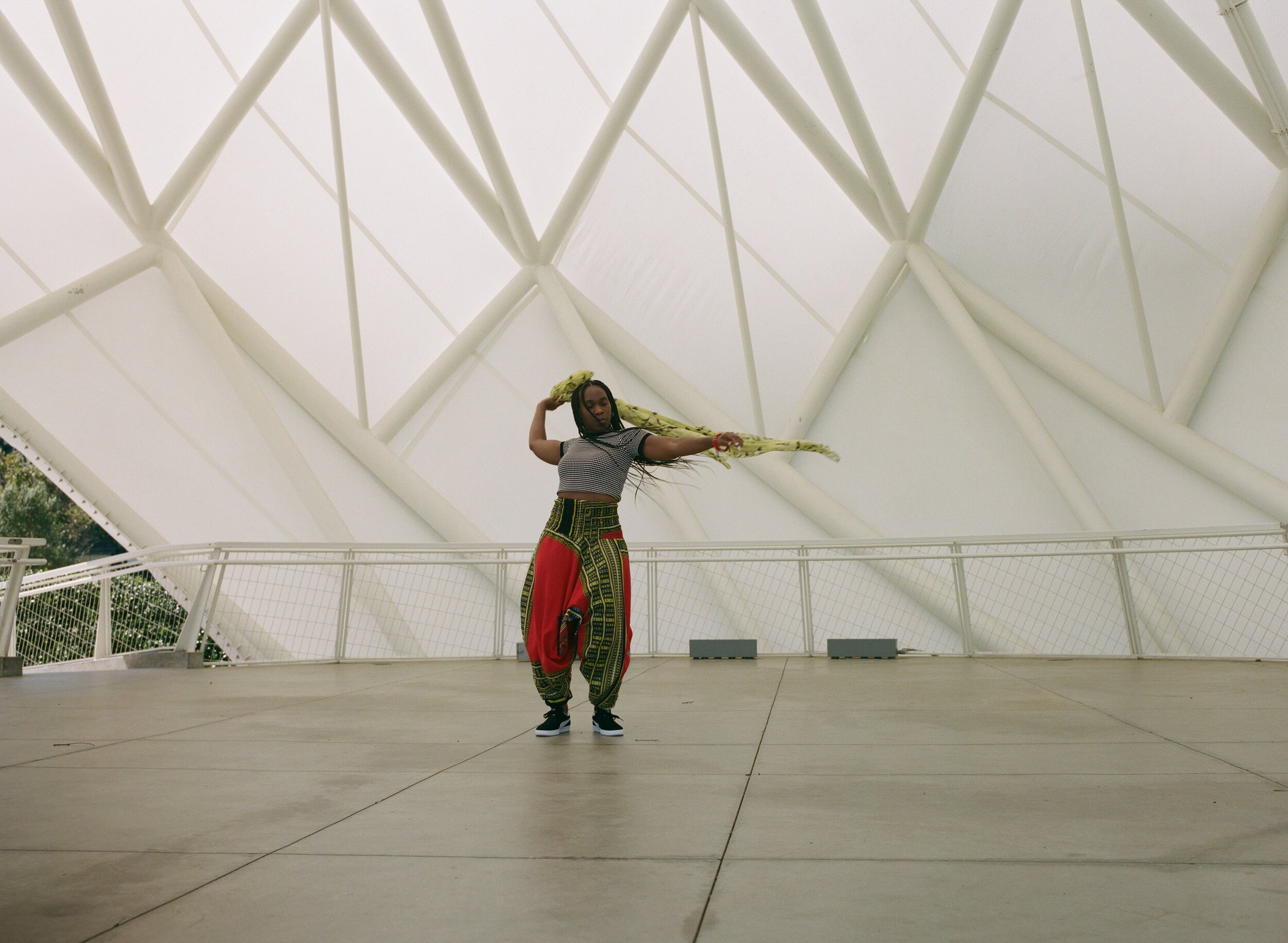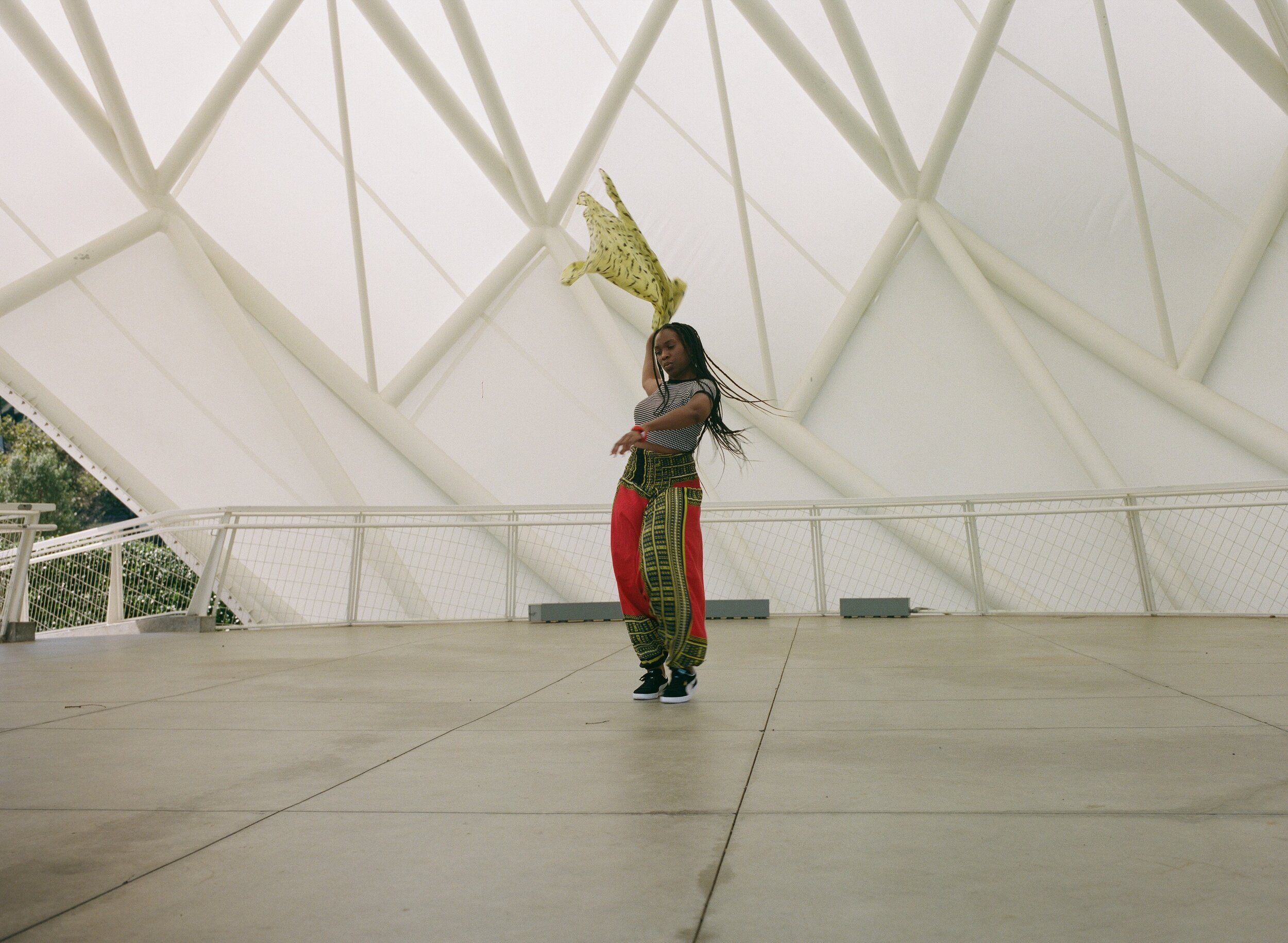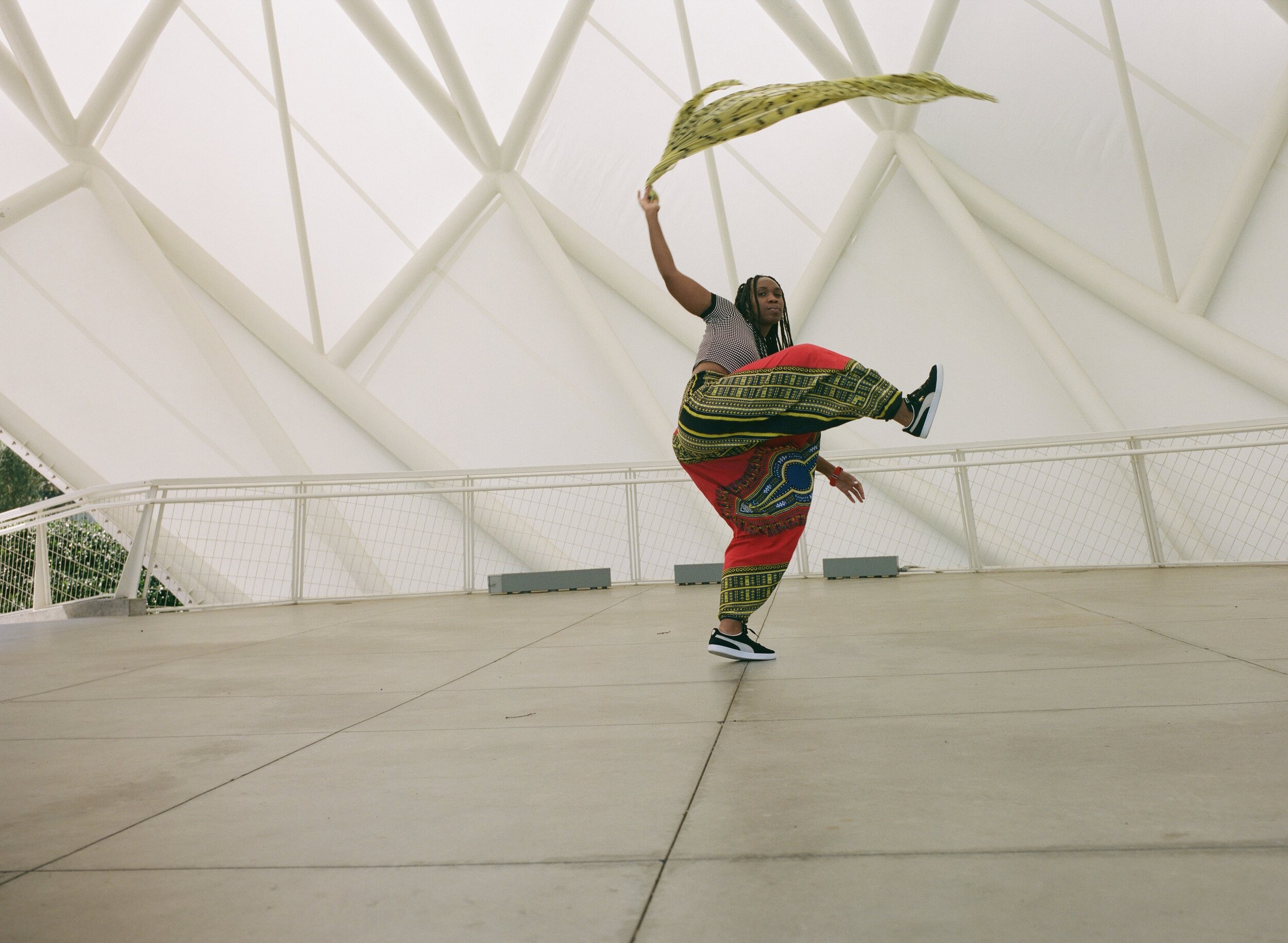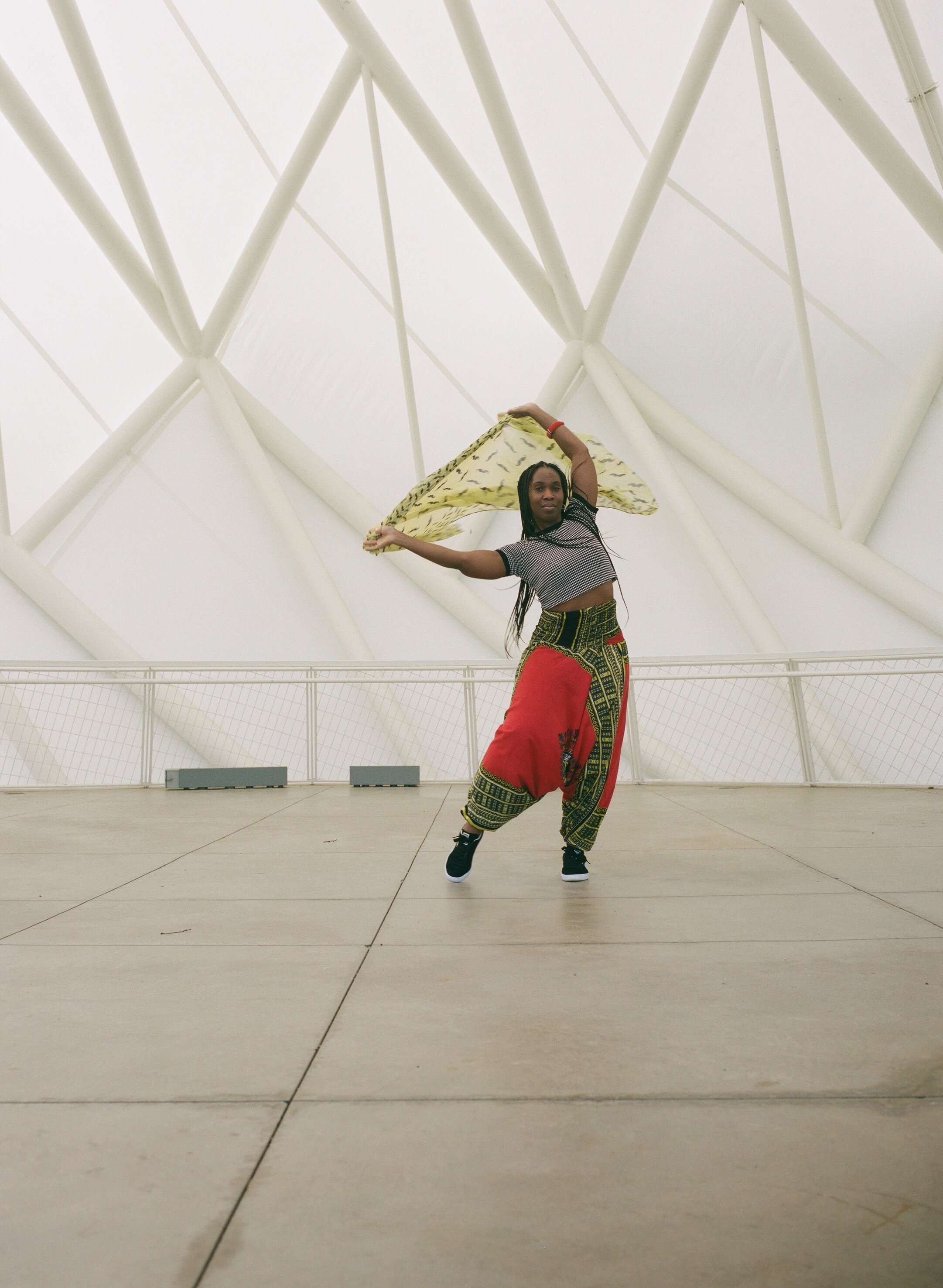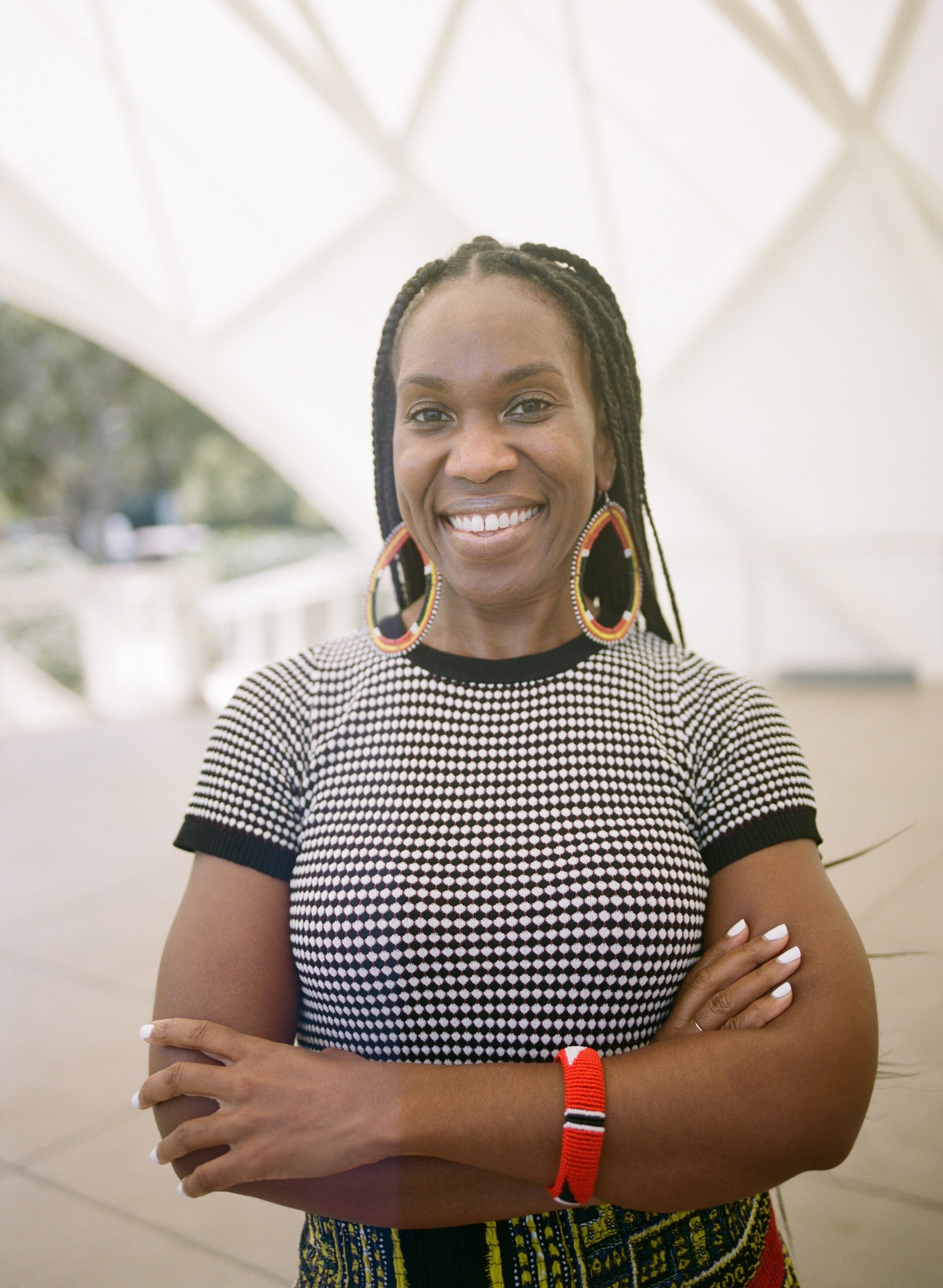Influential & Inspiring People
The IIP Series, also known as the Influential and Inspiring People Series, was created to showcase the many talented, hardworking, and innovative individuals I have had the privilege of knowing. I want to be able to share their stories while inspiring others to build their own paths along the way. My goal is to interview and photograph a list of (so-called “ordinary”) individuals who, in my eyes, are extraordinary. Many of them are making an impact in this world through their passions, and I want their stories to be heard. This one is FOR THE DANCE PRACTITIONER.
Nina Flagg
Nina has been inspiring me since 2015, my first year of college at California Institute of the Arts and my first time really understanding the foundations of Hip-Hop culture. Nina is an educator unafraid and unapologetic to speak her truth. Nina graduated from UCLA as a Sociology major with a specialization in Communications. She’s worked with big names in the industry along with both her parents being icons themselves in the dance and television industry. Nina had the privilege of directing and leading Alvin Ailey American Dance Theater who she also shared the screen with in a newly released Sundance film - Ailey (2021) directed by Jamila Wignot.
Nina has been an inspiration to many not only in the dance studio but in life after college. I recently had the opportunity to speak with her as not just a student anymore, since graduating from CalArts in 2019, but having the chance to speak as friends. Sometimes we take our teachers for granted, seeing them every day for class and not really knowing what their life consisted of prior to meeting them. I took every moment I could to ask her about her life leading up to this point in time and I was overwhelmed by the amount of information and advice I was able to take away from our conversation. Nina has been an inspiration in my life, in more ways than she knows, and I hope that after reading about her journey, she will also serve as an inspiration to yours.
1) What kind of impact did Alvin and Ailey dance company have on your decision to pursue dance as a career?
As a little girl of color, the pinnacle was dancing with the Ailey company. My mom is a dancer and started her professional career in New York doing Concert Dance, Broadway, and later Commercial Dance. She had friends in the Ailey company who she’d danced with early on in her career. Starting around the age of eight, she would take me every year to see the Ailey Company when they performed in Los Angeles. We would go with my dad as well. It was our tradition. My goal was always to one day dance with the Ailey company. I never really thought about how realistic or unrealistic that was. As a little girl, I didn’t think about body type or fitting a criteria. No one started to bring up those things until I was a little older. Early on, I just heard everyone talking about Ailey as the dream for Black dancers and that was my dream up until high school. Then I started to have a more realistic idea of what spaces were available to me as a full-bodied, curvy black girl who didn’t have a traditional dancer’s body but had all this training in Classical Ballet and Modern Dance. It was confusing. Where do I go with all of this? People would tell me that the talent was there but with my body type, I didn’t have many options as a professional dancer. I started to come to grips with the fact that Ailey was the dream but I had little chance of actually making it into the company.
There are politics in every institution. Even if I did have the body type, there are other factors that you don’t understand until you really understand the inner workings of organizations, how they read you, what they need at that time, etc. There’s always a formula. In most audition situations they are looking for someone who “looks like this” or “one of these” or “one of those”. Once that position is filled, they don’t need another one. Those are the things that they don’t say at auditions. I definitely think I would have pursued the Ailey track had I had a more traditional body type, but that doesn’t guarantee that I would have gone any farther.
So, working with the Ailey company over the past fifteen years with Rennie Harris has been a full-circle moment. I’ve had the pleasure of being Rehearsal Director and/or Assistant Choreographer for three of Rennie Harris’ original works on the Ailey Company and Assistant on a fourth work that he collaborated on with Robert Battle and Judith Jamison. The first time we worked with the Ailey company was in 2004.
Teaching company class, running rehearsals, setting choreography on the Ailey company, and working with dancers who I’ve idolized since I was a young girl has been amazing. I had to really get my nerves together the first time I walked into rehearsal because it was so overwhelming. The goal as a young girl was to one day get in the room with them as a company member, not knowing that I would ever be at the front of the room directing or leading a creative process. I only saw Ailey in a Contemporary dance context prior to working with them. I didn’t think the Ailey company would ever do anything remotely close to Hip-Hop or Street Dance. This is why I always stress the idea - Focus on the “WHAT” because the “HOW” is never going to look the way that you thought.
2) Did the journey that you took with dance ever put pressure on your shoulders needing to be as successful as your mom who is also highly respected in the dance field?
I started off as a gymnast and began my training at the age of three. I was a serious gymnast up until the age of twelve. That was what I was most passionate about even though I was also studying dance at the time. Gymnastics and dance kind of went hand in hand in terms of stamina, flexibility, agility and discipline but gymnastics is by far the toughest thing that I’ve ever had to do.
It’s a brutal sport and can be especially tough on little kids. The psychological effect, the conditioning… I wouldn’t say it’s healthy but it definitely set the mental and physical groundwork for how I approach any practice. The principles I learned as a gymnast have carried me throughout my dance career.
Gymnastics was the first thing that was my very own. No one else in my family had ever studied gymnastics or had any relationship to the culture. It gave me a sense of independence and identity as a young girl. It was something my mother fully supported but it gave us space because she couldn’t directly coach me on it. Later in life, Hip-Hop played a very similar role in our relationship. It allowed me to carve out my own identity in the dance world, separate from my mother’s legacy. I was free from the pressure of living up to my mother’s name in the Contemporary, Concert Dance, and Commercial Dance world. We also don’t share the same last name, so there are people who still don't know that we’re mother and daughter. Meaning, I can walk into a space and be received solely on what I’m presenting as an artist and not my last name. Over the years, both my mother and father have developed a tremendous respect and interest in Hip-Hop/Street Dance culture. They saw me dance with Rennie Harris’ Hip-Hop company early on in my career and it really opened them up to the depth of Hip-Hop dance theater. I’ve been able to share so much with them about the culture. I’ve even given my mom private House Dance and Dancehall classes the same way that she used to give me private Ballet and Modern dance classes when I was a young girl. My dad also takes my Dancehall classes. It’s amazing.
3) Could you give a brief History of Hip-Hop?
I can share the origins of Hip-Hop culture. The full history is much too vast to summarize.
The first thing that I always stress is that Hip-Hop is a culture. So many times when people say “Hip-Hop” they think of dance or of a type of music. Hip-Hop is made up of four main elements - The MC, the DJ, the B-boy, and Graff writing (graffiti writing.) Knowledge was later recognized as a fifth element, but those four main elements birthed the culture. Hip-Hop culture started in the Bronx, New York in the 1970s. There was a perfect storm of socioeconomic, political, and social elements occuring at the time.
I parallel it with what we saw in 2021 in terms of politics, race, and social justice issues coming to a head. The angst, the frustration of underserved communities, racism, systemic racism, police brutality, the clash of people’s ideologies; that kind of palpable, rebellious energy was also taking place during the birth of Hip-Hop culture. We had some of those same issues occurring, combined with the drug epidemic which removed a lot of parents from the home as they became addicts. There was also the building of the Cross Bronx Expressway which displaced a lot of families. There was White Flight - a lot of white business owners were burning down their businesses to collect insurance money so that they could leave the Bronx, which affected the presence of the middle class. You also had a young generation losing their leaders and heroes with the assassinations of Dr. Martin Luther King Jr., JKF, and Malcolm X. There was all of this shifting and change taking place that directly affected Black and Brown people. There is a really great film called “Rubble Kings” that’s told primarily from the Puertorican perspective of what was happening during the time. It gives an in depth understanding of what was taking place in the Bronx during the 60’s and 70’s.
You had a lot of kids who were searching for a sense of family and they often found that through street gang culture. You had different positions within street gangs which were taken very seriously. You had a member who would teach the gang how to fight and also teach the community how to protect themselves against police brutality. You had a peacemaker who would negotiate with the peacemakers from other gangs. Everybody had a position. In 1971, “Black Benjy”, a peacemaker from one of the main gangs was killed by a rival gang. Prior to that, peacemakers were off-limits, so the death of “Black Benjy '' started an all-out war in the Bronx. There was a summit between the street gangs and all of the gang leaders came together. They realized that they could either destroy each other and keep warring, which is what the media expected them to do, or they could take this moment to make a change and open up some dialogue. They chose the latter and that ushered in the social culture that ultimately became Hip-Hop. Gangs started to soften their territories. Prior to that, depending on your gang affiliation, you couldn't go into certain neighborhoods. There started being these block parties and people who never had the chance to interact with each other started dancing and partying together. People started to dress a little more fly in order to impress people from different neighborhoods. The street parties were a chance to dance, to rhyme, to come together and to have a good time without any drama. Instead of gangs battling each other through violence, B Boys and B Girls started boogying and battling each other in the cypher. That’s why you see so many battle gestures in Breaking/B Boying culture. It mimics the fighting style of gang rumbles. Then you had the MC who in the early days was on the mic making announcements like, “Hey so-and-so your car is about to get towed - Hey so-and-so your mom is here.” The DJ spun the records (music) and kept the party going. Then the DJ’s started asking MC’s to eat up a little more time while they changed records or took a bathroom break. MC’s started saying little clever rhymes to entertain the crowd and that eventually changed the role of the MC in Hip-Hop culture. Graff writers would spray paint their names, create art and murals around the neighborhood, and hit up the trains as a form of expression. There was also fashion and language (slang) that became specific to Hip-Hop culture. These are known as sub-elements in the culture. All of these things were coming together to shape what we now know as Hip-Hop. Then it became popular in mainstream culture with Rap music eventually being played on urban radio stations and music videos being shown on TV stations like MTV and The Box.
4) Do you feel like you still use your degree in your everyday life with dance?
Definitely. I graduated from UCLA with a degree in Sociology and a Specialization in Communications. I chose to study what I enjoyed. I was a Business Economics major for my first two years in college but I didn’t like it. I wanted to major in Business Administration but UCLA didn’t offer that at the time. I switched my major to Sociology in my third year because I really enjoyed my general education Sociology courses during my freshman and sophomore year. I wanted to do a double major in Communications, but it was too late to begin a Communications major in my third year. Instead, I chose a Specialization which was the equivalent of a minor.
I believe the study of people, communities, and their practices is at the core of studying and teaching dance. It helps me better understand how to reach others and give them an entry point into Hip-Hop culture. People don’t always think they’re welcome in Hip-Hop culture if they aren’t a person of color but that’s not necessarily the case. You must understand the people, their communities, and their traditions in order to relate to them. Then you will understand how to respectfully enter their world and how to invite them into yours. You will start to identify elements of your experience that parallel the experiences of others. Relatability breeds compassion, compassion makes room for communication, and communication makes room for understanding. I use this method to help people tap into the energy of Hip-Hop culture, as well as appreciate and respect it, rather than appropriate it. So in that sense, I feel like I use Sociology and Communications every day as an educator, artist, and human being.
5) How did you go about wanting to teach for higher education?
I never had it in my mind to teach in higher learning education. First of all, I thought it was where people went to retire at the end of their career. In my twenties, I was constantly on the road. I thought being on a faculty wouldn’t give me the freedom to travel and do all the things that I wanted to do. I didn’t want to be locked down. After graduating from college and touring with Rennie Harris’ company for a few years, I started getting approached to teach at higher learning institutions in LA. I would do brief choreography residencies or teach guest workshops for various departments but I always avoided adjunct positions. Rennie was on faculty at UCLA after we came off of tour and he asked me to assist some of his classes and even sub a few classes. UCLA was one of the first higher learning dance programs to add Hip-Hop dance to their curriculum in the early 2000’s. That experience gave me a better understanding of what it meant to teach at the college level. Eventually, UCLA invited me to join their program as guestpart-time faculty. I accepted but it was definitely an adjustment. I had to get acclimated to a regimented schedule, creating a curriculum which had to be reviewed by the department head, creating a Hip-Hop rubric for grading, etc. Then I started to get approached more and more by institutions who were in the beginning stages of introducing Hip-Hop Dance into their programs. I said no so many times because I thought it would keep me from being able to travel. That ended up backfiring. I would turn down faculty positions, not even end up traveling because I didn’t book traveling gigs, and then have to hustle to find dance work. As I got older, I realized that I needed to be a little more practical. I started understanding the ebb and flow of a dance career. Saying no to opportunities because I didn’t want to miss out on other potential jobs wasn’t a good strategy. That’s when I started saying yes to some of the offers. My intention was to bring the history, technique, and energy of Hip-Hop culture to these higher learning programs. I was clear that my offering as an educator had to include the language, the music, and the embodiment of Hip-Hop culture, as I knew it. I ended up having really great experiences in higher learning academia and have been received very well, but that’s not always the case. I think because I have a background in Classical Ballet and Contemporary dance it makes my colleagues more receptive to my teaching and my voice as a Hip-Hop practitioner. People with preconceived notions about Hip-Hop hear me speak about it in ways that parallel concepts in Classical Ballet and Contemporary dance and they become more curious about it. Dance is universal. At the end of the day, all dance is connected. It’s our ideas about dance that often separate us.
Hip-Hop culture is still threatening to some higher learning institutions because people who aren’t educated about the culture only associate it with lower-class communities, violence, misogyny, etc. “Hip-Hop” is still a threatening word for institutions with staunchly Eurocentric value systems. Even though Hip-Hop has permeated every part of the world and has become the dominant pop culture, it is still challenged in academic spaces. Those who are unwilling to progress past antiquated values and traditional dance hierarchies still question the legitimacy of Hip-Hop dance. As a Hip-Hop practitioner, I take pride in dismantling those outdated ideas and creating a stronger presence for Hip-Hop culture in the world of academia.
6) How are you kind to yourself on tough days and days where you don’t feel motivated to do what it is that you love to do?
Prior to the pandemic, my methodology was to just push through. Meaning, staying with it until there’s a breakthrough. As a creator, there are times when you can’t back off because you’re dealing with a deadline or time constraint. Even in the moments when I didn’t feel worthy as an artist, I just pushed through. That approach worked for me but it wasn’t necessarily healthy.
My mother once stated that she’s danced through life, death, birth, love, heartache…everything. That really resonated with me. I've always called on dance because it’s sustained me through every situation that life has thrown my way, including injury. Even when I couldn’t physically dance, I still thought about and imagined dance.
However, when the pandemic hit, I noticed that it was tougher for me to just push through when I wasn’t feeling inspired. I could do it when I had to teach but not when I took someone else's class. Sometimes I didn’t feel like taking class in my living room. I wanted to be in a studio with people. I tried to keep pushing towards a breakthrough but sometimes I just couldn’t get there. It was the first time that I experienced that kind of block where I couldn’t shift the energy. It was the first time I couldn’t just push through. I started focusing on other forms of inspiration outside of dance. I started thoroughly observing and studying people who are exceptional at their craft; whether it be architecture, agriculture, science, braiding, painting. Over the past year and a half, this has become an equally powerful source of inspiration for me. Before the pandemic, nothing could rival the inspiration I felt from dance.
I still believe in pushing through because I grew up on the tail end of old-school dance training. The stakes were so high for the generations before me. People went to such great lengths to be able to dance and you would never dare take that for granted. You would never miss an opportunity to dance because it was so incredibly precious. I feel like it’s the responsibility of my generation to honor that. I still believe in pushing through but now I also recognize that stillness, pause, and self-care are as valuable as movement.
7) What’s the best advice anyone has ever given you?
The best choreographic advice that I ever learned was when I was working with Ms. Tina Turner. One of my dear mentors, Toni Basil, brought me on board her choreographic team for Tina Turner’s final world tour. I was in my twenties and full of energy. We were in rehearsal choreographing all of these intricate steps for one of the numbers and Ms. Tina slowed us down and said, “No, no. People want something that they can do along with me...When people come to my concerts they want to know that they can do one thing and then they remember that one thing when they go home.” As an example, she started swinging her arm and doing the iconic rock back and forth that she does at the beginning “Proud Mary”. I never forgot that…The power of simplicity. When you’re choreographing, there needs to be a moment of simplicity that lets the viewer in. When you are executing all of these intricate things, sometimes people don’t know what they’re looking at. Sometimes it’s so far away from them that it’s not even relatable anymore. Provide that moment of simplicity to let a person who's never danced a day in their life, look at it and actually feel something. Bring the audience with you. Let them feel a groove, a sway, a relatable moment. There was a shift when Ms. Tina said that to me.
Another great piece of advice was from my godfather Otis Sallid, who’s also a renowned choreographer and director. When I graduated from college, he bought me three practical but stylish watches and he said, “If you’re early, you’re on time - If you’re on time, you’re late - If you’re late, don’t bother showing up.” That was the first time I’d ever heard that saying. It’s a very old saying, but he’s the first person that ever said it to me. I never forgot it and that’s why I stress the importance of being early.
My father also gave me some great advice through example. He works in the television industry and throughout his 40+ years in the business, he’s never compromised his integrity to get ahead. I’ve used that approach throughout my dance career. I’ve never backstabbed people or compromised my morals to secure an opportunity. It’s not easy to resist shortcuts or temptation. It doesn’t make you popular and it certainly doesn’t make you first, but I’m able to sleep well at night. My father also told me that, as a person of color, I have the right to question and challenge things. Don’t let anyone make you feel lesser than or that you don’t have the right to open your mouth and exercise your voice.
8) What kind of advice do you have for anyone deciding to pursue dance as a career but struggling to commit to a degree?
My first piece of advice would be to understand the difference between a career and a job. If you are really trying to have a career in dance, know that it’s made up of many different things. It’s dynamic and can include dancing, teaching, choreographing, curating, mentoring, serving on an arts advisory board, creating programs, being a dean, being a creative director, yoga & pilates certification, etc. There are so many ways to engage in dance without it solely being a physical practice. When you are used to training as a young person, you think that’s all there is… “I’m gonna dance for a living.”
But a career in dance involves so many other things and you can still live a dance-centric life without having to be a dancer 24/7. You can audition and do all of the things but also be thinking about other ways that you are interested in dance so that it becomes a way of life. It’s not a job. It becomes a career and a body of work.
A college career in dance academia has the potential to provide you with more information. Information is the thing that’s going to sustain you in the long run. Physicality is the thing that’s going to sustain you in the short run. We’re living in a time where you have to be able to be competitive with your peers as a practitioner but also as a thinker. Beyond the physical practice, it's the ideas, experimentation, information, and individuality that higher learning dance education provides which ultimately sets you apart from your peers. Those things become even more significant when participating in the global dance conversation and later on in your career. If you can commit to a degree without acquiring massive debt, take the opportunity.
If I hadn’t grown up with a mother who danced professionally and also had her own dance company, I probably would’ve majored in dance. I don’t think a higher learning dance education is ever a waste because you are learning how to study, how to research, how to create, how to present, and how to speak to an audience all through the lens of dance. Of course, it comes down to picking the best program for you.
My follow-up advice would be to give things time once you graduate. If somebody says, “Hey do you want to come here for six months or a year and do this project” but it doesn’t quite look like what you had in mind, say yes. Even if it doesn’t fit your list of goals, it becomes part of your experience which inevitably lends itself to your body of work. Understanding what you do want, sometimes entails understanding what you don’t want. There is always something to be learned, so nothing is ever a waste of time. Be open and understand that a dance career in today’s world is broad and long. A year sounds like a long time but it's really not. I hear people who just started teaching say, “ I taught at a studio for three weeks and no one came to my class.” Try something for three months, six months, not three weeks. There’s no overnight success. Even when something looks like an overnight success, it usually isn’t. And there’s always the day after, and the day after that, and the day after that. That’s when dance education comes into play.


